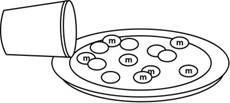|
Get
a Half Life!: Student Worksheet

Name: ___________________________________

A decay function is one
in which the values decrease by a constant factor, but it is not linear!
These functions are often used to model the decay of a radioactive
element. The half-life of a substance is the time it takes to reduce
its initial effectiveness by one-half.

Students work in pairs.

Each pair needs:
- 1 cup of m&m's
- 1 paper plate or box
- 1 graphing calculator

- Collect the Data
- Pour m&m's out and count your beginning sample size
(N). This will be your N value when T = 0. Enter this value in
the table below and put the m&m's back in the cup.
- Shake the cup gently and pour the m&m's out in the
box or on the paper plate.
- Remove all the m&m's with an "m" showing.
(You may eat these m&m's only!)
- Count the remaining m&m's and enter this value of
N into your table next to T = 1.
- Put the remaining m&m's back in the cup.
- Repeat this process until there are no longer any m&m's
with the letter "m" when you empty your cup.
| Trial
Number (T) |
0
|
1
|
2
|
3
|
4
|
5
|
6
|
7
|
| #
of remaining m&m’s (N) |
|
|
|
|
|
|
|
|
- Use the Calculator
- Clear out the calculator:
Press [2nd][Y=]. Enter [4]. Press [ENTER]. This turns off all
plots.
Press [Y=], [CLEAR], down arrow and [CLEAR] until all equations
are cleared.
Press [STAT], [ENTER] to view tables. To clear Lists, press up
arrow to highlight L1, press [CLEAR], [ENTER]. Use arrow keys
to highlight any other lists and clear.
- Enter the data from the table above:
Press [STAT], choose EDIT by pressing [ENTER] and enter values
of T in L1 using down arrow keys and [ENTER].
Use right arrow key to move over to L2 and enter the values of
N in L2.
- Graph the Data
Press [STAT PLOT] ([2nd][Y=]), choose 1 by pressing [ENTER].
Highlight: ON
Broken line graph
Xlist: L1
Ylist: L2
Mark: first one
Press [ZOOM], then [9] to set up appropriate window and see graph.
- Have the calculator determine the best equation for the data.
Linear:
Press [STAT]. Choose CALC[5].
Type in L1, L2 (press [2nd][1][,][2nd][2] then [ENTER]). You will
see y = ax + b and values for a, b, and r.
Press [Y=], set cursor next to Y1=, press [VARS][5], arrow over
to EQ, press [7], the [GRAPH].
Quadratic:
Press [STAT], choose CALC [6], then type in L1, L2 (like above)
and press [ENTER].
Press [Y=]. Set your cursor next to Y2=.
Press [VARS][5], arrow over to EQ, press [7], the [GRAPH]. (Adjust
the window here to see more of this graph)
Exponential:
Press [STAT] and choose CALC . Choose A by using the down arrow
key until you see "A ExpReg". Press [ENTER].
Type in L1, L2 as before and then [ENTER]. You will see y = a*b^x
(y = abx) and values for a, b, and r.
Press [Y=] and set your cursor next to Y3=.
Press [VARS], choose [5], arrow over to EQ, press [7], then [GRAPH].
- Analyze the Data
- Which graph most clearly approximates a "curve of best
fit" for your data?
- Why is this called a "half-life"?
- What is a good estimate for the length of a "half-life"
of m&m's based on your research?

As a result of this activity,
students learn to model a real-life situation by collecting data from
a few trials, graphing the data, and then drawing a curve of best
fit. The student must decide which of the equations best fits his/her
data. Sometimes when a student gathers his/her own data, the graph
does not make a perfect line or curve.

- Describe the factors that
influenced you to choose your "curve of best fit".
- Explain how each of the three types of equations, linear, quadratic,
and exponential, are different.
|